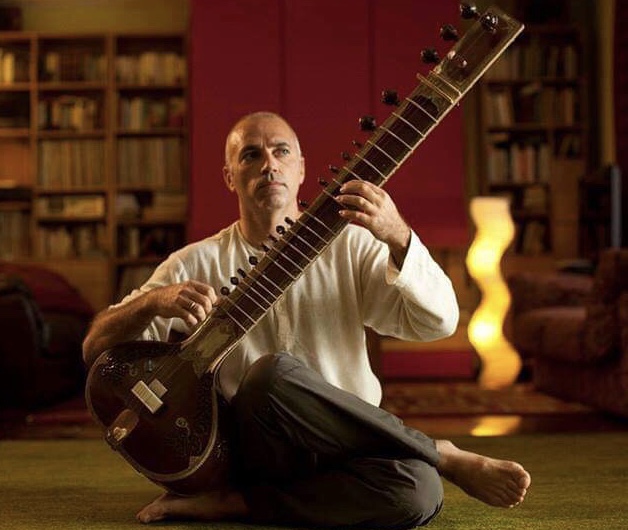Every morning starts with a meditation session lead by Nektarios Mitritsakis. He will use music as the root of the sessions.
Nektarios Mitritsakis was born in Chania, Greece. From a very a young age he was expressing himself through his connection to nature and music, till at the age of 25 he decided to focus intensively on music. His journey through music took him through Rock, Jazz, Blues and also traditional Cretan music. Till in ’95 he first heard an Indian classical music concert which inspired him to travel to India and return back with a Sitar. He started his first classes with Ross Daly, studying Sitar, Saz and Cretan Lyra. From ‘98 and for the next decade he spent long periods every year in Varanasi, North India studying the Sitar and Surbahar with Rabindra Narayan Goswami.
Over the span of those years he was able to work with many of the great Indian classical musicians and to participate in various festivals like Dhrupad mela of Varanasi. His studies were focussed on his teacher’s methods and guidance as is usual in the tradition of Guru-Shishya but he also received a degree for the Sitar from Prayag Sangit Samiti of Allahabad of north India. Parallel to his musical studies in his search for a connection to body and soul he studied Vedic astrology, Ashtanga Yoga and Vipassana meditation and has included them in his lifestyle since.
From the very beginning of his studies in India he loved the method of Dhrupad style of music and got most of his inspiration that lead him to start his studies of the main instrument of this style the Rudra Veena with Bahauddin Dagar at 2008. Today he lives in Crete and keeps traveling to India, sharing his knowledge and experience through teaching music and yoga. Through his concerts the listener can experience the musical journey through sound with peace and beauty.
Indian classical music belongs to the same group as Greek, Turkish and Arab music. That approach is known as modal music. In this category each vibration or phrase is related to the main note of the musical scale that is used as a base and through which can be experienced and understood the micro-notes (shrutis) between each note.
What makes Indian classical music so special is its profound relationship with meditation, a way to spiritual development of the musician and listener through the sound (Nada). Though it is rich in lyricism and sensitivity mostly it aims to inspire a deep inner stillness within it’s listener.
Although the introverted beauty of this music can be treated as entertainment it is actually more of a meditation through the sound. While those listeners familiar with this music may more readily experience these deeper meditative aspects, even those new to this type of music can enjoy and benefit from it’s therapeutically qualities.
Indian classical music through the Raga is a very special approach that can reach deep in the psyche of a person and offer many therapeutic benefits. The term ‘Raga’ means ‘color the mind’. Groups of notes are used in particular way and in certain combinations and emphasis, so as to generate a feeling that accords with the character of the Raga.
Many spiritual traditions use different points to concentrate the mind; images, symbols, and geometric shapes such as Yantras; verbal or mental phrases such as Mantras, Koan, prayers. Each of these forms of concentration creates an image within which is used as a connection to a positive state of being. The use of a Raga as a means either just through it’s sound or combined with singing is a practice in yoga through sound, and a path to Nada (sound) Bhrahma (Creator). In most every part of the planet and its’ sacred scriptures we will find words similar to “… and creation began with the use of word and sound…”. An old story says that God once asked the soul to enter the human body, but the soul refused due to the body’s limitations. The God commanded Angels to sing, then the soul being ecstatic from dance entered the human body. Since then, whenever the soul hears music, we can experience, even for few moments, that freedom again, a sense of timelessness or a journey beyond the narrow limits of a human body. There are many Ragas that are played or sung at certain times of the day (sunrise, sunset, evening, late night) but also in particular seasons of the year. Of the different styles of Indian classical music we can find today the oldest one is Dhrupad. The emphasis is on Alap, Jor, Jhala that is an introductory presence of a Raga for a melodic musical instrument or the voice. Though in the beginning we do not get a feeling of rhythmic pattern it develops from a slow to fast tempo followed by a composition.
This style of music is mostly improvised, and is developed through many years of study and practice. An Indian classical music concert could be imagined as a painting that’s painted right in front the audience. Today we find this music in concert halls, but its most origin is from meetings in small houses they called ‘bhaitak’ in India, giving the picture of a meditation group.
